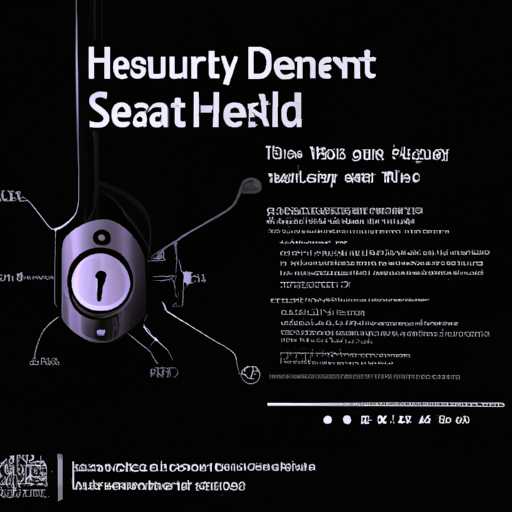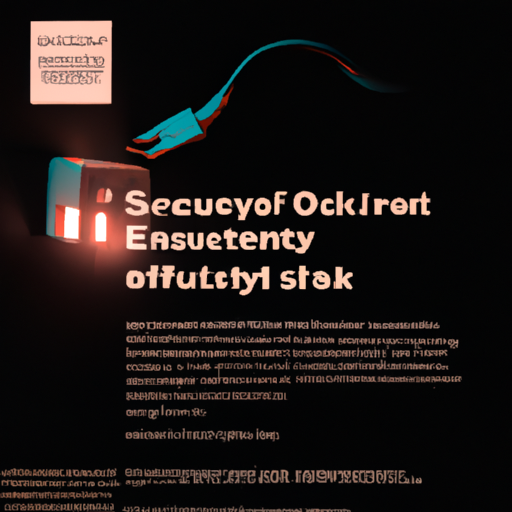Hey, have you ever wondered about the security risks that come with using smart home devices? It’s definitely worth taking a closer look at. Smart home devices have become increasingly popular, allowing us to control various aspects of our homes with just a few taps on our smartphones or even through voice commands. But with this convenience comes the concern of potential security vulnerabilities.
When it comes to smart home devices, there have been reports of possible security risks that users should be aware of. These devices, such as smart speakers, thermostats, and security cameras, may collect and store sensitive personal information. Without proper security measures in place, there is always a potential for hackers to gain unauthorized access to these devices, compromising our privacy and security. It’s essential to understand the potential risks associated with these devices so that we can make informed decisions to protect ourselves and our homes.

Understanding Smart Home Devices
Smart home devices refer to a collection of interconnected devices and appliances that can be controlled and monitored remotely using internet connectivity. These devices are designed to enhance automation, convenience, and comfort in our everyday lives. From adjusting the thermostat to turning off the lights, smart home devices offer a host of benefits. In this article, we will explore the various aspects of smart home devices, including their definition, types, and the rapid growth of smart home technology.
Defining smart home devices
Smart home devices are electronic appliances or systems that are connected to a network and can be controlled remotely using a smartphone, tablet, or computer. These devices are equipped with sensors, processors, and internet connectivity, allowing them to interact with users and other devices through wireless or wired communication protocols. Examples of smart home devices include smart thermostats, smart speakers, smart security systems, smart lighting, and even smart refrigerators. With their ability to automate tasks and provide seamless connectivity, smart home devices have become an integral part of modern homes.
Types of smart home devices
Smart home devices encompass a wide range of categories, catering to various needs and preferences. Let’s delve into some of the most common types of smart home devices:
-
Smart Thermostats: These devices enable homeowners to control and monitor their home’s temperature remotely. They use sensors and algorithms to optimize energy usage, providing increased comfort while reducing energy costs.
-
Smart Speakers: Smart speakers, such as Amazon Echo or Google Home, utilize voice recognition technology to interact with users and perform a multitude of tasks. From playing music to providing weather updates and controlling other smart devices, smart speakers have become a central hub in many smart homes.
-
Smart Security Systems: These devices include smart door locks, motion sensors, surveillance cameras, and video doorbells. They provide homeowners with the ability to monitor and secure their homes remotely, enhancing safety and peace of mind.
-
Smart Lighting: Smart lighting systems allow users to control the intensity, color, and scheduling of their lights. Whether it’s creating ambiance or enhancing energy efficiency, smart lighting systems offer flexibility and convenience.
-
Smart Appliances: From refrigerators and washing machines to coffee makers and ovens, smart appliances provide users with enhanced functionality and convenience. They can be controlled remotely, offer energy-saving features, and even provide notifications and alerts.
Rapid growth of smart home technology
Over the past decade, smart home technology has experienced exponential growth, revolutionizing the way we interact with our living spaces. The global smart home market is expanding rapidly, driven by advancements in technology, increased awareness, and the growing desire for convenience and automation.
The market is projected to witness significant growth in the coming years, with more households adopting smart home devices. According to market research, the global smart home market is expected to reach a value of $174.24 billion by 2025.
The rising popularity of smart home devices can be attributed to several factors. Increasing connectivity, the proliferation of mobile devices, and the rise of artificial intelligence have created a favorable environment for smart home technology. Additionally, the growing emphasis on energy efficiency, sustainability, and home security has contributed to the widespread adoption of smart home devices.
With the potential to transform our daily lives and make homes more comfortable and secure, smart home devices have become an integral part of the modern lifestyle. However, it is crucial to understand the potential security risks associated with these devices to ensure a safe and protected smart home ecosystem.
Benefits of Smart Home Devices
Smart home devices bring numerous benefits to homeowners, ranging from increased convenience and automation to energy efficiency and cost savings. Let’s explore some of the key advantages of incorporating smart home devices into our daily lives.
Convenience and automation
One of the primary benefits of smart home devices is the convenience they offer. From controlling multiple devices with a single command to automating routine tasks, smart home devices streamline our daily routines. For instance, with a smart speaker, you can play your favorite music, set timers, and even order groceries without lifting a finger. Smart lighting systems allow you to create personalized lighting schedules and ambiance, eliminating the need to manually adjust lights throughout the day. These conveniences enhance comfort and make our lives more efficient.
Energy efficiency and cost savings
Smart home devices can contribute to energy savings and reduced utility bills. Smart thermostats, for example, optimize energy usage by learning user behavior, sensing occupancy, and adjusting temperature settings accordingly. This not only results in increased comfort but also reduces energy waste. Similarly, smart lighting systems can automatically turn off lights in unoccupied rooms, ensuring that energy is not wasted. By monitoring and controlling energy consumption, smart home devices offer significant cost savings over time.
Enhanced security and safety
Smart home devices provide homeowners with enhanced security and peace of mind. Smart security systems, including surveillance cameras, door locks, and motion sensors, enable remote monitoring and control of home security. This allows homeowners to keep a constant watch on their property, receive instant notifications of any suspicious activities, and even remotely lock or unlock doors. Additionally, smart smoke detectors and carbon monoxide detectors provide early warnings of potential hazards, ensuring the safety of occupants. With these features, smart home devices contribute to a secure and protected living environment.
Common Security Risks
While the advantages of smart home devices are indisputable, it is essential to acknowledge the potential security risks they pose. As with any internet-connected device, smart home devices are vulnerable to various security threats. Let’s examine some of the common security risks associated with these devices.
Weak device authentication
Device authentication plays a critical role in securing smart home devices. Weak or default passwords and inadequate authentication mechanisms can leave devices vulnerable to unauthorized access. Attackers can exploit these vulnerabilities to gain control over devices, compromising privacy and potentially even gaining access to the entire home network. It is crucial for users to set strong, unique passwords and enable two-factor authentication whenever possible to reduce the risk of unauthorized access.
Inadequate encryption protocols
Proper encryption is essential for ensuring the confidentiality and integrity of data transmitted between smart home devices and their associated applications or cloud servers. Weak or outdated encryption protocols can make it easier for attackers to intercept and manipulate sensitive information. It is crucial for device manufacturers and developers to implement strong encryption algorithms and stay updated with the latest security standards to protect user data from unauthorized access.
Vulnerabilities in smart home hubs
Smart home hubs act as central control units, connecting various devices within the smart home ecosystem. However, these hubs can become potential targets for attacks if they have security vulnerabilities. Exploiting these vulnerabilities can allow attackers to gain control over the entire network of connected devices, compromising the privacy and security of the entire system. Regular security audits, timely software updates, and adherence to industry best practices can help mitigate these risks.
Privacy concerns and data breaches
Smart home devices collect and process vast amounts of data, ranging from device usage patterns to personal preferences and sometimes even video or audio recordings. Privacy concerns arise when this data is stored or transmitted insecurely or when it is used without the user’s consent. Data breaches can occur if attackers gain unauthorized access to user data stored on cloud servers or within the device itself. Manufacturers must prioritize data security and ensure robust encryption, secure storage, and responsible data handling practices to protect user privacy.
Physical theft of devices
While online security risks are significant, physical theft of smart home devices can also pose privacy and security concerns. Stolen devices may contain personal information or data that can be exploited by attackers. To mitigate this risk, users must secure their premises and take additional precautions such as disabling remote access for stolen devices and reporting the theft to the appropriate authorities.
It is crucial for users to be aware of these potential security risks associated with smart home devices and take necessary precautions to safeguard their privacy and security. In the following sections, we will delve deeper into specific security threats and explore ways to mitigate them effectively.
Hacking and Unauthorized Access
Smart home devices, like any other internet-connected device, are susceptible to hacking and unauthorized access. Attackers are constantly evolving their tactics to exploit vulnerabilities and gain control over these devices. Understanding the techniques employed by attackers can assist in implementing effective security measures. Let’s explore some of the most common hacking methods used against smart home devices.
Exploiting default credentials
One of the most common and easily avoidable security risks is the use of default credentials. Many smart home devices come with preconfigured usernames and passwords, making them vulnerable to unauthorized access. Attackers can compile lists of default credentials and use brute-force or dictionary attacks to gain access to devices. To mitigate this risk, users must change default credentials immediately after setting up their smart home devices and adopt strong, unique passwords.
Brute force and dictionary attacks
Brute force and dictionary attacks involve systematically guessing or attempting multiple passwords until the correct one is discovered. These attacks rely on the use of automated tools that rapidly try various combinations of usernames and passwords to gain access to smart home devices. To protect against these attacks, users must choose strong passwords and use two-factor authentication whenever possible. Implementing account lockout policies, where access is temporarily denied after multiple failed attempts, can also help mitigate these risks.
Man-in-the-middle attacks
Man-in-the-middle (MITM) attacks occur when an attacker intercepts and alters communications between a user device and a smart home device, gaining unauthorized access to sensitive information or inserting malicious commands. These attacks often target devices connected to unsecured or compromised networks. To protect against MITM attacks, users must ensure their Wi-Fi networks are encrypted and secured using protocols such as WPA2 or WPA3.
Infiltration through unsecured networks
Smart home devices rely on internet connectivity, making them susceptible to attacks if the network they are connected to is unsecured. Attackers can exploit vulnerabilities in the network to gain access to connected devices and potentially compromise the entire home network. Users must ensure that their home networks are properly secured, using strong passwords and encryption protocols. Regularly updating router firmware and disabling any unused network services can further enhance network security.
Mitigating these hacking techniques and unauthorized access requires a proactive approach from users. By implementing robust security practices, such as using strong passwords, enabling two-factor authentication, and securing Wi-Fi networks, users can significantly reduce the risk of unauthorized access to their smart home devices and personal information.

Malware and Remote Attacks
Malware and remote attacks pose significant threats to the security and privacy of smart home devices. Malicious software can infect devices, compromising their functionality and potentially enabling remote control by attackers. Let’s examine some of the common types of malware and remote attacks targeting smart home devices.
Spyware and remote surveillance
Spyware refers to malicious software designed to collect sensitive information, such as keystrokes, screen capture data, or audio recordings, without the knowledge or consent of the user. Smart home devices that have built-in cameras, microphones, or voice recognition capabilities can be targets for spyware. Users must prioritize the security of their smart home devices by using reputable and regularly updated antivirus and anti-malware software to detect and remove any potential threats.
Distributed Denial of Service (DDoS) attacks
Distributed Denial of Service (DDoS) attacks aim to overwhelm a targeted device or network with a flood of traffic, rendering it unavailable to legitimate users. Smart home devices with internet connectivity can be unwittingly used as part of a botnet to launch DDoS attacks. To protect against this type of attack, users must ensure that their smart home devices are running the latest firmware or software updates, as manufacturers often release security patches to address vulnerabilities that could be exploited by attackers.
Compromised firmware updates
Firmware updates are crucial for keeping smart home devices secure by fixing vulnerabilities and improving overall performance. However, attackers can target the update process and distribute malicious firmware updates that compromise the device’s security. Users must ensure that firmware updates come from trusted sources and that their devices are set to automatically install updates from the manufacturer. Verifying the authenticity of firmware updates and performing regular checks for updates can help protect against this type of attack.
Exploiting unpatched vulnerabilities
Smart home devices, like any other technology, may contain software vulnerabilities that can be exploited by attackers. Manufacturers often release security patches to address these vulnerabilities; however, if users fail to install these updates, their devices remain vulnerable. Users must actively monitor for updates and promptly install them to protect against potential threats.
By staying vigilant and implementing proactive security measures, users can effectively guard against malware and remote attacks. Regularly updating device firmware and software, using reputable antivirus and anti-malware software, and practicing safe browsing habits are essential steps in maintaining a secure smart home environment.
Implications for Personal Privacy
The proliferation of smart home devices has raised concerns about personal privacy. As these devices collect and process vast amounts of data, questions arise about the potential misuse or unauthorized access to personal information. Let’s explore the implications of smart home devices on personal privacy.
Collection and misuse of personal data
Smart home devices gather extensive data about user behavior, preferences, and even audio or video recordings. This data can be exploited for various purposes, such as targeted advertising or even sold to third parties without the user’s knowledge or consent. It is essential for users to review privacy policies, understand what data is collected, and exercise caution when granting permissions or sharing personal information with smart home devices or associated applications.
Smart devices as potential surveillance tools
Smart home devices with cameras and microphones have the ability to capture audio and visual data, raising concerns about potential surveillance. While these devices are intended to enhance security and convenience, it is crucial to be aware of the potential privacy risks associated with their usage. Users should consider the placement and settings of such devices to strike a balance between security and privacy.
Risks to personal privacy rights
The widespread adoption of smart home devices has prompted discussions about the implications for personal privacy rights. As the connectivity and capabilities of smart home devices evolve, regulations and policies must adapt to protect individual privacy. Users must be mindful of their rights and advocate for transparent data practices and robust security measures when using smart home devices.
It is imperative for manufacturers to prioritize user privacy by implementing security measures, such as end-to-end encryption, anonymization of data, and clear consent mechanisms. Regulatory bodies and policymakers also play a crucial role in establishing comprehensive privacy frameworks and ensuring compliance by device manufacturers.

Securing Smart Home Devices
Securing smart home devices is essential to mitigate potential security risks and protect personal privacy. Let’s explore some of the best practices that users can adopt to enhance the security of their smart home devices effectively.
Implementing strong passwords and authentication methods
One of the easiest and most effective ways to secure smart home devices is by using strong, unique passwords and enabling two-factor authentication whenever possible. A combination of letters, numbers, and special characters should be used for passwords, and they should be updated regularly. Two-factor authentication adds an extra layer of security by requiring users to provide an additional piece of information, such as a fingerprint or a one-time verification code.
Keeping firmware and software up to date
Regularly updating device firmware and software is essential to address security vulnerabilities and ensure optimal performance. Manufacturers often release updates that include security patches and bug fixes. Users should enable automatic updates or regularly check for updates through the manufacturer’s official channels to protect their devices against potential threats.
Configuring routers and networks securely
Securing the home network is crucial, as it serves as the foundation for smart home device connectivity. Changing default router credentials, disabling remote access to the router’s management interface, and using strong encryption protocols such as WPA2 or WPA3 can help significantly enhance network security. Network segmentation can also be implemented to isolate smart home devices from personal devices, reducing the potential impact of a compromise.
Using network segmentation
Implementing network segmentation involves creating separate subnets for smart home devices and personal devices, effectively isolating the two networks from one another. This enhances security by limiting the potential impact of a compromised smart home device on personal devices and data. Users can achieve network segmentation through advanced router settings or by using dedicated smart home hubs that create separate network segments.
Investing in trusted smart home devices
When purchasing smart home devices, users should prioritize reputable manufacturers and well-established brands known for their commitment to security and privacy. Researching a device’s security track record, reading user reviews, and checking for certifications, such as the UL 2900 certification for cybersecurity, can help users make informed decisions and invest in trusted devices.
While user actions can significantly enhance the security of smart home devices, industry collaboration and regulatory frameworks are also crucial. Manufacturers, industry associations, and regulatory bodies must work together to establish rigorous security standards, promote responsible data practices, and ensure compliance across the smart home ecosystem.
Regulations and Standards
The rapid growth of smart home technology has prompted the need for regulations and standards to address security and privacy concerns. Let’s explore the current regulatory landscape and existing cybersecurity standards for smart home devices.
Current regulatory landscape
Regulatory frameworks governing smart home devices vary across countries and regions. For example, the European Union has implemented the General Data Protection Regulation (GDPR), which aims to protect the privacy and personal data of EU citizens. The United States has various federal and state laws that touch upon privacy and data protection, including the California Consumer Privacy Act (CCPA). However, comprehensive regulations specifically targeting smart home devices are still evolving.
Cybersecurity standards for smart home devices
In addition to the absence of specific regulations, the smart home industry lacks a universally adopted set of cybersecurity standards. However, various organizations and industry associations have developed guidelines and standards to address security and privacy concerns. For example, the Underwriters Laboratories (UL) has introduced the UL 2900 cybersecurity certification program, which is designed to assess the security of network-connectable devices, including smart home devices. Additionally, organizations like the Internet Engineering Task Force (IETF) and the International Electrotechnical Commission (IEC) are actively developing technical standards for smart home technology.
The need for industry collaboration
To ensure consistent security and privacy standards for smart home devices, industry collaboration is critical. Manufacturers, government agencies, industry associations, and consumer advocacy groups must collaborate and share best practices and research findings. This collective effort can help establish a robust framework that not only safeguards user privacy but also ensures the long-term viability and growth of the smart home industry.

Future Outlook and Concerns
As smart home technology continues to advance, it is essential to anticipate and address emerging security threats and challenges. Let’s explore the future outlook of smart home devices and the concerns surrounding their security.
Continued proliferation of smart home technology
The adoption of smart home devices is projected to increase significantly in the coming years. As technology evolves and becomes more affordable and accessible, more households are expected to integrate smart home devices into their lifestyles. This rapid proliferation raises concerns about the security and privacy implications for millions of users worldwide.
Emerging security threats and challenges
With the growing popularity of smart home devices, security threats are also evolving. Hackers are constantly devising new techniques to exploit vulnerabilities and gain unauthorized access to these devices. As devices become more interconnected and networked, the potential risk and impact of security breaches continue to escalate.
Additionally, as smart home devices become integral parts of our daily lives, the stakes are higher. Compromised security or privacy breaches can potentially impact everything from personal safety to financial well-being. It is crucial for manufacturers, users, and regulatory bodies to remain vigilant and responsive to emerging security threats and challenges.
Balancing convenience with security
One of the main challenges faced by the smart home industry is striking a balance between convenience and security. Users demand seamless integration and automation, but it is essential to ensure that these conveniences do not compromise the security and privacy of individuals. Industry stakeholders must prioritize security throughout the design and development process, taking into account potential risks and implementing appropriate safeguards.
Conclusion
As the adoption of smart home devices continues to rise, so do the security risks associated with these devices. Understanding the potential threats and implementing robust security measures is crucial to safeguard personal privacy and protect against unauthorized access.
In this article, we have explored the definition and types of smart home devices, the benefits they offer, and the common security risks associated with them. We have delved into various security threats, such as hacking, malware, and remote attacks, and discussed potential solutions and best practices to enhance device security. Additionally, we have examined the implications of smart home devices on personal privacy, the need for regulations and standards, and the importance of industry collaboration.
Going forward, it is essential for users, manufacturers, regulatory bodies, and industry associations to work together to establish comprehensive security standards and practices. By recognizing the importance of smart home device security, addressing security risks comprehensively, and staying informed and proactive, we can enjoy the conveniences of smart home technology while safeguarding our privacy and peace of mind.

